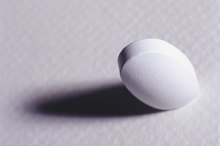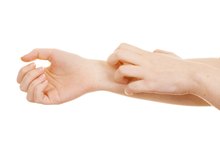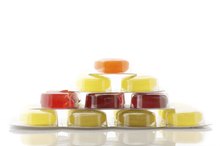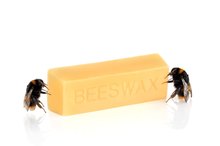How to Remove Zinc Cream
Typically used as a natural sunscreen or a treatment for minor skin irritations, zinc oxide cream has a lot to offer -- it physically blocks nearly all harmful UV rays when applied topically, handily resists water and doesn't soak into the skin, unlike penetrating sunscreens that sometimes contain endocrine-disrupting chemicals. On the flip side, some of the qualities that make zinc cream useful -- namely its water resistance and barrier-like properties -- also mean it requires extra care when it comes to removal.
Read more about itchy, dry skin and zinc.
Rinse your face or the area to which you have applied zinc oxide cream or sunscreen thoroughly with warm water 1. If you have lots of zinc on your body, hop into a warm shower for easier, more contained removal.
Zinc Citrate Side Effects
Learn More
Work mild, natural liquid or bar soap between your wet hands to generate a thick, foamy lather. Ingredients such as jojoba oil, peppermint oil, hempseed and soybean make for effective natural soaps. For particularly stubborn or dried-on zinc, turn to a soap with light exfoliating elements, such as burnt sugar or vanilla beans.
Work the lather into a clean, gently abrasive or textured sponge, loofah or washcloth. Massage the zinc with the lathered sponge, loofah or washcloth, applying a bit of pressure and working in circular motions. This method slowly but surely removes zinc from the skin.
Skin Rashes & Zinc
Learn More
Rinse thoroughly with warm water and repeat the rinsing, lathering and massaging process until your skin is free of zinc.
Read more about how to treat a reaction to sunscreen.
Tips
As a topical cream, zinc oxide treats minor burns, cuts and scrapes, but not deep or severe wounds. To prevent irritation and pain, turn to softer cleaning cloths and focus on rinsing the zinc with warm water rather than scrubbing when removing zinc from injured skin.
To avoid staining your clothes with zinc-based sunscreen or other zinc oxide creams, wait for any topical application of the product to dry completely for a few minutes before letting clothing or fabrics touch it directly.
Remove chalky white zinc oxide stains from clothes by dabbing the stain with a solution of 1 part water and 1 part rubbing alcohol until the spot lifts. Then, launder your clothes as usual.
Warnings
Always read and follow any instructions or warnings provided by the manufacturer or your zinc oxide cream or sunscreen.
Related Articles
References
- The Dr. Oz Show: Your Sunscreen Might Be Poisoning You
- W.S. Badger Company, Inc.: Badger Natural Sunscreen FAQ
- Today: Clean Up Your Act! The Best All-Natural Soaps
- HealthCentral: A & D Zinc Oxide Cream Top Uses and How to Use
- National Institutes of Health. Office of Dietary Supplements. Zinc Fact Sheet for Health Professionals. Updated March 6, 2020.
- Wessels I, Maywald M, Rink L. Zinc as a Gatekeeper of Immune Function. Nutrients. 2017;9(12):1286. doi:10.3390/nu9121286
- Mousa HA. Prevention and Treatment of Influenza, Influenza-Like Illness, and Common Cold by Herbal, Complementary, and Natural Therapies. J Evid Based Complementary Altern Med. 2017;22(1):166-174. doi:10.1177/2156587216641831
- Krebs NF, Miller LV, Hambidge KM. Zinc deficiency in infants and children: a review of its complex and synergistic interactions. Paediatr Int Child Health. 2014;34(4):279-288. doi:10.1179/2046905514Y.0000000151
- Gogia S, Sachdev HS. Zinc supplementation for mental and motor development in children. Cochrane Database Syst Rev. 2012;12:CD007991. doi:10.1002/14651858.CD007991.pub2
- Ogawa Y, Kinoshita M, Shimada S, Kawamura T. Zinc and Skin Disorders. Nutrients. 2018;10(2):199. doi:10.3390/nu10020199
- Gupta M, Mahajan VK, Mehta KS, Chauhan PS. Zinc Therapy in Dermatology: A Review. Dermatol Res Pract. 2014;2014:709152. doi:10.1155/2014/709152
- Khan WU, Sellen DW. World Health Organization. Zinc supplementation in the management of diarrhoea. 2011.
- Petrilli MA, Kranz TM, Kleinhaus K, et al. The Emerging Role for Zinc in Depression and Psychosis. Front Pharmacol. 2017;8:414. doi:10.3389/fphar.2017.00414
- Fallah A, Mohammad-Hasani A, Colagar AH. Zinc is an Essential Element for Male Fertility: A Review of Zn Roles in Men's Health, Germination, Sperm Quality, and Fertilization. J Reprod Infertil. 2018;19(2):69‐81.
- Zhao J, Dong X, Hu X, et al. Zinc levels in seminal plasma and their correlation with male infertility: A systematic review and meta-analysis. Sci Rep. 2016;6:22386. Published 2016 Mar 2. doi:10.1038/srep22386
- U.S. Department of Agriculture, Agricultural Research Service. Oysters, Raw. FoodData Central. Updated 2020.
Writer Bio
Dan Ketchum has been a professional writer since 2003, with work appearing online and offline in Word Riot, Bazooka Magazine, Anemone Sidecar, Trails and more. Dan's diverse professional background spans from costume design and screenwriting to mixology, manual labor and video game industry publicity.









